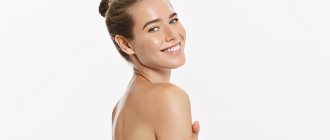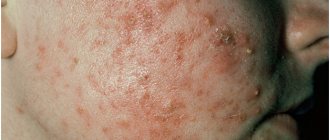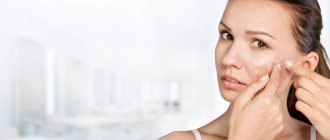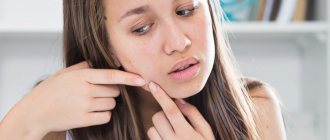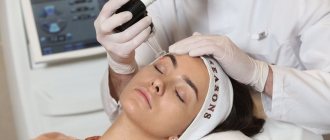Retinoids (in-depth review)
Acnecutane, Roaccutane, Erase
Acnecutane, Roaccutane, Erase
Systemic retinoids contain the active ingredient isotretinoin. This substance has been used in world medicine for almost 40 years and is the gold standard for the treatment of acne and acne.
What kind of substance is this? This is trans-retinoic acid and it very powerfully suppresses the activity of the sebaceous glands.
When does acne occur?
Acne occurs when, under the influence of excessive effects of the hormone testosterone on the sebaceous gland, powerful production of sebum in large quantities is stimulated.
How do systemic retinoids work?
Systemic retinoids act on the sebaceous gland receptors, joining the sebaceous gland receptors, they inhibit the activity of sebum secretion from the gland and acne goes away.
The most frequently prescribed drugs from systemic retinoids (approved in the Russian Federation):
- Roaccutane
- Aknekutan
- Will erase
Comment from cosmetologist, dermatologist Yuliana Shiyan:
When I prescribe one of these drugs, I am asked why this particular drug and what is the difference between retinoids? All these drugs have one substance in common: Isotretinoin. Roaccutane was the very first to appear. This is the original drug, and all other drugs are its *generics. All generics of isotretinoin have their own registration certificates and are approved in Russia.
*GENERIC - approved copy of the original drug
Roaccutane and Sotret practically do not differ from each other either in formula or dose. When assigning them, there is no difference and the choice in favor of one or the other is immaterial. Acnecutane contains the same substance, but its formula is slightly different from Roaccutane and Sotret.
Why is Acnecutane more interesting for a cosmetologist and the patient himself, as a choice for treatment and how to understand which retinoid drug is better?
Isotretinoin is a fat-soluble substance. It is absorbed by the body only in combination with absorbed fats. If you take Roaccutane and wash it down with plain water, you will absorb less than 40% of it. If you take Acnecutan and drink it with plain water, it will be absorbed by the body by about 70%.
When prescribing Acnecutane, the doctor insures patients against their own mistakes. Patients may neglect fatty foods while taking Roaccutane and Sotret, forget to eat anything fatty or fatty foods are forbidden to them (on a diet), and the required dose of the drug must enter the body! Necessary, not a small part of it! Therefore, the drug Acnekutan is more preferable for the patient; a lack of fat when taking it is less likely to affect the outcome of treatment.
Its daily dose is regulated by the doctor, but there is also a cumulative dosage of the drug that the patient’s body must accumulate. It is when it is achieved that we can talk about a high chance of stable remission in the patient.
Due to the fact that Acnecutane is better absorbed, the manufacturer made slightly less active ingredient in one dose, which means: The working dose is 20 mg. Roaccutane corresponds to the working dose of Acnecutane with 16 milligrams of Isotretinoin.
The conclusion is simple: if less isotretinoin accumulates in the body, then the risks of side effects are also reduced. This is very good for the patient!
For ardent supporters of all original and original drugs, Roaccutane is recommended. But all other retinoids will be useful for you, provided that they are prescribed by a dermatologist, and you, in turn, comply with all the conditions for taking retinoids.
The effectiveness of systemic retinoids for acne
Acne (acne vulgaris) is one of the most common skin diseases, affecting up to 90–95% of the world's population at various stages of life [1]. Moreover, the incidence of the disease at the age of 12–25 years reaches 85%. When establishing the etiology and pathogenesis of acne, the genetic and constitutional characteristics of the body play a certain role. It has been shown that the incidence of acne in a child exceeds 50% if both parents have it [2, 3]. As a result of recent studies, it has been established that the development of acne occurs against the background of several interrelated pathogenetic mechanisms. The most significant of them are: disruption of keratinization processes, pathological follicular hyperkeratosis, excess production of sebaceous secretions, accompanied by an imbalance of lipids and the proliferation of microorganisms [4–6]. In most cases, acne is considered as a constitutionally determined disease with increased sensitivity of sebocytes to androgenic stimuli [7, 8]. It has been proven that the intensity of sebum secretion, the size and number of sebaceous glands, and readiness for the inflammatory process are genetically determined, however, genetic factors can play an important role in the development of sebaceous gland disease only when the genetic predisposition is combined with the influence of other environmental factors. The appearance of rashes during severe acne can subsequently lead to pronounced cosmetic defects, the presence of which negatively affects the psycho-emotional state of patients, reduces self-esteem, causes depressive disorders, and leads to social maladjustment. Even with mild to moderate severity of acne vulgaris, a number of patients experience psychological discomfort, increased situational and personal anxiety, and various types of nosogenic depression, most often recorded in women. 90% of patients suffering from acne experience aesthetic discomfort, 62% have difficulties communicating with other people, 45% report difficulties in work or study [9]. Despite the largely known mechanism for the development of acne vulgaris, treatment still poses certain difficulties. The treatment tactics for patients with acne vulgaris are determined by the clinical form and severity of the disease, the age and gender of the patient, concomitant diseases, previous treatment and its effectiveness, the characteristics of the development and course of relapses, and their duration. For mild cases of acne vulgaris, as a rule, only external therapy and proper skin care are prescribed, and for moderate and severe cases, systemic therapy is prescribed, which includes three main groups of drugs (antibiotics, synthetic retinoids, hormonal drugs). Oral antibiotics are prescribed to suppress microbial colonization. Antibiotics of the tetracycline group, including doxycycline, tetracycline, and minocycline, are the main ones in acne treatment regimens, but tetracycline is currently practically not used. Recently, the problem of the development of antibiotic resistance as a result of long-term use has become extremely relevant. Resistance to erythromycin and clindamycin is most often observed. In past years, the development of resistant strains of Propionibacterium acnes was very rare, however, many studies now show that more than 60% of patients treated with antibiotics for more than 1 month develop resistance to erythromycin, and the likelihood of developing resistance to oral taking an antibiotic is as great as taking an external one, and therefore it is not recommended to prescribe antibiotics as monotherapy. According to European recommendations, in the treatment of moderate and severe acne vulgaris, it is advisable to combine oral antibiotics with external agents containing retinoids or benzoyl peroxide; in women, their combination with hormonal therapy is possible. For women with hormonal disorders, recurrent acne vulgaris, resistant to external therapy, treatment with sex hormones is recommended. Taking oral hormones reduces sebum secretion and inhibits the effects of androgens in the sebaceous glands. For the treatment of acne, three groups of hormones are mainly used: estrogens, which suppress ovarian androgens; glucocorticoids, which inhibit adrenal androgens, and oral antiandrogens, which act primarily at the peripheral level. Estrogens in small dosages (35–50 mcg), used as oral contraceptives, can significantly reduce sebum secretion. Treatment with antiandrogens is carried out after consultation with a gynecologist-endocrinologist, and may require an assessment of the hormonal profile of the blood (luteinizing hormone, follicle-stimulating hormone, estradiol, progesterone, testosterone, prolactin and dehydroepiandrosterone sulfate), ultrasound of the pelvic organs and adrenal glands, radiography or tomography of the skull. Systemic retinoids, in particular isotretinoin, remain the most effective in the treatment of acne. The drug is indicated for patients with nodular cystic acne and often recurrent inflammatory rashes in whom antibiotic treatment has been ineffective, as well as for patients with a tendency to scar formation; and the range of indications for isotretinoin is expanding. Isotretinoin, being a comedolytic, acts on pathological follicular keratinization and reduces the function of the sebaceous glands, and has a direct antichemotactic and anti-inflammatory effect. Despite the fact that isotretinoin does not have a direct antibacterial effect, it is able to influence the process of chemotaxis and phagocytosis and thus reduce the number of propionbacteria [10]. Already after 2 weeks. After starting treatment with isotretinoin, a decrease in sebum production is observed. As a result, the growth of microorganisms and pro-inflammatory mediators is sharply reduced, so today isotretinoin is the only drug that affects most of the pathogenesis of acne. This occurs due to the molecular mechanisms of action of isotretinoin, which, interacting with nuclear receptors, reduces the differentiation of sebaceous gland cells, which contributes to a pronounced decrease in the size and activity of sebocytes. It is known that isotretinoin at a dose of 0.5–1.0 mg/kg per day significantly reduces sebum secretion (by 80%) within 6 weeks. after starting treatment. The drug is prescribed for a long term - from 4 months. up to 1 year, in doses from 0.1 mg/kg to 1 mg/kg body weight, depending on the severity of the disease. A prerequisite is to take the drug with food. Unfortunately, due to the fear of developing side effects while taking isotretinoin, doctors do not always prescribe the drug in a timely manner. Usually the drug causes concern among doctors who have no experience in its use. There is an opinion that after completion of treatment you cannot become pregnant for 2 years, while isotretinoin is mistakenly attributed to the properties of other retinoids (etretinate and acitretin), which, unlike isotretinoin, have a long half-life. However, the half-life of isotretinoin is only 19 hours; however, protection from pregnancy is necessary for the entire period of therapy and 1 month. after its completion. Side effects can indeed accompany the course of treatment, but in most cases we are talking about cheilitis and dry skin. Other side effects, such as transient changes in transaminases, headache, myalgia, deterioration of night vision, described in the instructions for use of the drug, are much less common and, as a rule, do not require cessation of treatment. In order to minimize the risk of developing side effects from the liver and pancreas during treatment with isotretinoin, manufacturers recommend constant monitoring of biochemical blood parameters (liver enzymes, cholesterol and triglyceride levels): after 3–4 weeks. after the start of treatment, and then once every 1–2 months, more often if indicated. It is important to remember that isotretinoin monotherapy is recommended. Concomitant use with tetracyclines should be avoided to avoid an increase in intracranial pressure. For the treatment of severe forms of acne, the drug Acnecutan (manufactured using the Lidose technology patented in Belgium), the active ingredient of which is isotretinoin, has been successfully used over the past years. As is known, isotretinoin is a poorly soluble compound and is not completely absorbed in the digestive tract. Lidose technology consists of adding 2 additional components to each capsule of the drug Acnecutan (Gelucir and Span), due to which the dissolved fraction of isotretinoin in each capsule increases, and the drug is more fully absorbed in the digestive tract compared to the usual form of isotretinoin. Bioavailability increases by 20% compared to the regular form of isotretinoin, which makes it possible to reduce the amount of isotretinoin in each capsule by 20% while maintaining the therapeutic effectiveness of the drug. Acnecutane is available in capsules of 8 and 16 mg, which are bioequivalent to capsules of 10 and 20 mg with regular isotretinoin. At the same time, from 16 mg of Acnecutane, 12 mg of isotretinoin enters the blood, the same as from 20 mg of the usual form of the drug, and the amount of inactive isotretinoin is reduced by 2 times (4 mg in Acnecutane and 8 mg in preparations of the usual form of isotretinoin). This, in turn, reduces the likelihood of side effects and improves tolerability of the drug. Another important point is that the bioavailability of Acnecutane depends on food intake much less compared to the regular form of isotretinoin. When taken without food, Acnecutane is absorbed by 70%, while the usual form of isotretinoin is only absorbed by 38%. Thus, the use of Acnekutan allows you to reduce the amount of isotretinoin entering the body by 20% without compromising the therapeutic effectiveness of the drug. In addition, occasional doses of the drug without food will not lead to a reduction in the course dose of isotretinoin. The recommended daily dose of Acnecutan is 0.4–0.8 mg/kg, and the course dose is 100–120 mg/kg body weight. In connection with the above, we would like to share our experience of using Acnecutan in patients with acne. Under our supervision at the Clinic of Skin and Sexually Transmitted Diseases named after. A.V. Rakhmanov there were 46 patients: 25 (54.3%) men and 21 (45.7%) women aged from 15 to 38 years with a disease duration of 2 to 23 years. 30 (65.3%) patients had moderate severity and 16 (34.7%) had severe severity. The severity of the disease was determined using the dermatological acne index (DIA) (N.G. Kochergin, D.V. Ignatiev, 2004) by counting the number of formations on the skin - papules, pustules and nodes [11]. In patients with moderate severity, the DIA value corresponded to 7.59±1.12 points, and in patients with severe severity – 11.32±1.43 points. Anamnestic studies revealed that patients in the past were treated with various methods with multiple courses, including systemic antibiotics, metronidazole, antiandrogens, external agents, cleansing, peeling, etc., but the treatment gave only a temporary clinical effect. Treatment with Acnecutane was carried out after examination (clinical and biochemical blood tests), at a rate of 0.4–0.8 mg/kg per day with meals. To level out the phenomena of xerosis and cheilitis, all patients used moisturizing cream for dry and sensitive skin 2-3 times a day and moisturizing lipsticks. When a pronounced improvement in the clinical picture was achieved, the daily dose of Acnecutane was gradually reduced, and when the cumulative dose reached 100 to 120 mg/kg (114.5 ± 4.4 mg/kg), treatment was stopped. As a result of the therapy, a 100% reduction in DIA was observed in patients with moderate acne, i.e., clinical remission was achieved. In severe cases, the reduction in DIA was 94%, which corresponded to almost complete clinical remission (Fig. 1, 2).
During therapy, patients noted dryness of the lips (46 patients - 100%) and face (34 patients - 74%) to varying degrees of severity, especially in the first months of therapy. If the dryness of the face in most patients was relieved by the use of a moisturizing cream for dry and sensitive skin, then cheilitis, despite the use of moisturizing lipsticks, accompanied the entire course of Acnecutane therapy, but not a single patient expressed a desire to stop treatment, seeing the impressive clinical effect of Acnecutane. One patient, in the 5th month of taking Acnekutan, complained of arthralgia, which completely resolved within 3 weeks. after treatment with non-steroidal anti-inflammatory drugs. With monthly monitoring of biochemical blood parameters, 22 (48%) patients showed minor changes (less than 20%) in triglycerides, high- and low-density lipoproteins and atherogenicity coefficient, which completely returned to normal after treatment. The listed side effects did not require discontinuation of the drug. When surveyed, all patients reported that the treatment was tolerated well. Thus, our many years of experience have shown that Acnecutan is a highly effective drug for the treatment of moderate and severe acne, its effectiveness corresponds to the original isotretinoin drug, but at the same time Acnecutan has an advantage in tolerability of treatment over drugs of conventional forms of isotretinoin [12], and is also more convenient for patients in terms of less dependence of drug intake on food. As a rule, systemic isotretinoin therapy leads to recovery or significant improvement in the skin condition of patients with acne, and also provides long-term remission of the disease. However, in some cases (10–25%), a second course of therapy may be required, which can be carried out no earlier than after 8 weeks. after completion of the previous course of treatment. Relapse may be associated with the lack of correction of concomitant diseases that play an important role in the pathogenesis of acne. Therefore, before starting treatment, it is important to exclude conditions such as polycystic ovary syndrome, thyroid disease, impaired carbohydrate tolerance, and congenital adrenal hyperplasia. In addition, premature cessation of treatment with Acnecutane without reaching a cumulative dose of 100–120 mg/kg may also contribute to the development of relapses.
Retinol and tretinoin
To increase the effectiveness of treatment, you can use medicinal creams and ointments containing not retinol, but pure retinoic acid - tretinoin . A drug with tretinoin, compared to a drug with retinol, at a concentration several times lower, has the same effective effect on the skin; when the concentration increases (to a reasonable limit), its therapeutic effect increases. But at the same time, some people may experience side effects in the form of allergic reactions to pure tretinoin - mild itching, peeling, etc. These effects disappear as the body gets used to the drug. You can read about side effects here.
The mechanism of absorption of retinol and tretinoin by skin cells
Skin cells contain receptors that interact with retinoic acid. Activation of receptors leads to the development of a signal for the cell nucleus to begin the synthesis of certain organic substances.
The chain of chemical reactions is as follows: retinol, interacting with alcohol dehydrogenase enzymes, changes and turns into retinoaldehyde. At the next stage, this substance becomes retinoic acid - an intercellular communicator. Retinoic acid can also be formed from esters of retinyl palmitate and retinyl acetate, which, interacting with the enzyme esterase, are converted first into vitamin A (retinol), and then, along the chain described above, into retinoic acid.
Side effects from treatment with systemic retinoids
Therapy with systemic retinoids should only be carried out under the supervision of a specialist. While taking these medications, you need to take a biochemical blood test once a month: check the level of liver enzymes (ALT, cholesterol, alkaline phosphatase, AST, triglycerides). If these indicators increase, the specialist may reduce the dose of the medicine. If there is an increase in triglycerides and there are complaints about the functioning of the liver and gastrointestinal tract, it is necessary to additionally check the levels of lipase and amylase in order to detect pancreatitis in time44.
When treating acne* with retinoids, you should stop drinking alcohol and use sunscreen. The drug should not be combined with tetracycline, since both drugs can increase intracranial pressure44.
Retinoids may cause the following side effects44:
- cheilitis;
- dry skin;
- conjunctivitis,
- dry mucous membranes;
- increased photosensitivity;
- deterioration of night vision;
- headache;
- myalgia, arthralgia;
- transient hair loss.
The most common situation that worries patients at the beginning of treatment with systemic retinoids is the so-called retinoic dermatitis. It develops approximately when a certain cumulative dose of the drug is reached in the blood. This reaction is considered normal. Irritation and redness of the skin appear, especially in places where it is thin. Itching and sensitivity may be felt.29
Side effects stop after you stop taking the drugs. In the first 30-60 days, symptoms may worsen. It is highly not recommended to reduce the dosage on your own or stop taking medications; you should contact a specialist who, if necessary, will adjust the course of therapy44.
